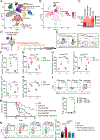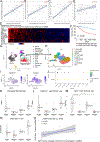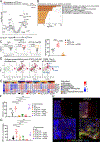CTLA-4 blockade induces a microglia-Th1 cell partnership that stimulates microglia phagocytosis and anti-tumor function in glioblastoma
- PMID: 37572655
- PMCID: PMC11800830
- DOI: 10.1016/j.immuni.2023.07.015
CTLA-4 blockade induces a microglia-Th1 cell partnership that stimulates microglia phagocytosis and anti-tumor function in glioblastoma
Abstract
The limited efficacy of immunotherapies against glioblastoma underscores the urgency of better understanding immunity in the central nervous system. We found that treatment with αCTLA-4, but not αPD-1, prolonged survival in a mouse model of mesenchymal-like glioblastoma. This effect was lost upon the depletion of CD4+ T cells but not CD8+ T cells. αCTLA-4 treatment increased frequencies of intratumoral IFNγ-producing CD4+ T cells, and IFNγ blockade negated the therapeutic impact of αCTLA-4. The anti-tumor activity of CD4+ T cells did not require tumor-intrinsic MHC-II expression but rather required conventional dendritic cells as well as MHC-II expression on microglia. CD4+ T cells interacted directly with microglia, promoting IFNγ-dependent microglia activation and phagocytosis via the AXL/MER tyrosine kinase receptors, which were necessary for tumor suppression. Thus, αCTLA-4 blockade in mesenchymal-like glioblastoma promotes a CD4+ T cell-microglia circuit wherein IFNγ triggers microglia activation and phagocytosis and microglia in turn act as antigen-presenting cells fueling the CD4+ T cell response.
Keywords: AXL; CD4(+) T cell; CTLA-4; MER; MHC-II; glioblastoma; immunotherapy; microglia.
Copyright © 2023 Elsevier Inc. All rights reserved.
Conflict of interest statement
Declaration of interests S.M.K. is on the scientific advisory boards and has equity in EvolveImmune Therapeutics, Affini-T Therapeutics, Arvinas, and Pfizer.
Figures







Similar articles
-
Colon Immune-Related Adverse Events: Anti-CTLA-4 and Anti-PD-1 Blockade Induce Distinct Immunopathological Entities.J Crohns Colitis. 2017 Oct 1;11(10):1238-1246. doi: 10.1093/ecco-jcc/jjx081. J Crohns Colitis. 2017. PMID: 28967957
-
Vectorized Treg-depleting αCTLA-4 elicits antigen cross-presentation and CD8+ T cell immunity to reject 'cold' tumors.J Immunother Cancer. 2022 Jan;10(1):e003488. doi: 10.1136/jitc-2021-003488. J Immunother Cancer. 2022. PMID: 35058324 Free PMC article.
-
Uniting innate and adaptive immunity in glioblastoma; an α-CTLA-4 quest.Trends Immunol. 2023 Dec;44(12):933-935. doi: 10.1016/j.it.2023.10.011. Epub 2023 Nov 8. Trends Immunol. 2023. PMID: 37949785
-
The role of T-cell-mediated mechanisms in virus infections of the nervous system.Curr Top Microbiol Immunol. 2001;253:219-45. doi: 10.1007/978-3-662-10356-2_11. Curr Top Microbiol Immunol. 2001. PMID: 11417137 Review.
-
CTLA-4 blockade increases antigen-specific CD8(+) T cells in prevaccinated patients with melanoma: three cases.Cancer Immunol Immunother. 2011 Aug;60(8):1137-46. doi: 10.1007/s00262-011-1011-9. Epub 2011 Apr 5. Cancer Immunol Immunother. 2011. PMID: 21465316 Free PMC article. Review.
Cited by
-
Phagocytosis Checkpoints in Glioblastoma: CD47 and Beyond.Curr Issues Mol Biol. 2024 Jul 23;46(8):7795-7811. doi: 10.3390/cimb46080462. Curr Issues Mol Biol. 2024. PMID: 39194679 Free PMC article. Review.
-
Machine Learning Links T-cell Function and Spatial Localization to Neoadjuvant Immunotherapy and Clinical Outcome in Pancreatic Cancer.Cancer Immunol Res. 2024 May 2;12(5):544-558. doi: 10.1158/2326-6066.CIR-23-0873. Cancer Immunol Res. 2024. PMID: 38381401 Free PMC article.
-
Advancing Cancer Treatment: A Review of Immune Checkpoint Inhibitors and Combination Strategies.Cancers (Basel). 2025 Apr 23;17(9):1408. doi: 10.3390/cancers17091408. Cancers (Basel). 2025. PMID: 40361336 Free PMC article. Review.
-
Targeting immune microenvironment in cervical cancer: current research and advances.J Transl Med. 2025 Aug 8;23(1):888. doi: 10.1186/s12967-025-06896-3. J Transl Med. 2025. PMID: 40781691 Free PMC article. Review.
-
Investigating the Role of Lactate-Related Genes in Radiotherapy Resistance of Lung Cancer by Integrated Bioinformatics and Experiment Validation.J Cancer. 2025 Jul 24;16(11):3296-3313. doi: 10.7150/jca.113046. eCollection 2025. J Cancer. 2025. PMID: 40861806 Free PMC article.
References
-
- Hara T, Chanoch-Myers R, Mathewson ND, Myskiw C, Atta L, Bussema L, Eichhorn SW, Greenwald AC, Kinker GS, Rodman C, et al. (2021). Interactions between cancer cells and immune cells drive transitions to mesenchymal-like states in glioblastoma. Cancer Cell 39, 779–792 e711. 10.1016/j.ccell.2021.05.002. - DOI - PMC - PubMed
Publication types
MeSH terms
Substances
Grants and funding
LinkOut - more resources
Full Text Sources
Molecular Biology Databases
Research Materials
Miscellaneous

